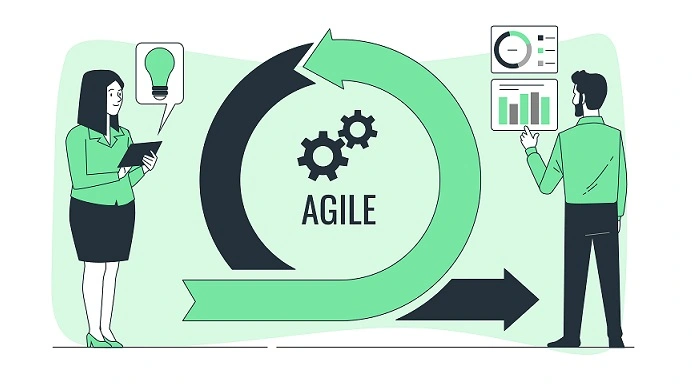Remote work has rapidly become prevalent, calling for innovative teamwork and project administration methods. Agile teams must find creative solutions to keep productivity, transparency, and communication levels high while working remotely.
The ability to visualise work, track progress, and coordinate activities effectively has made Virtual Scrum Board a valuable tool for managing remote teams in Agile environments.
This blog will review the challenges of leading Agile remote teams and solutions for managing them using virtual Scrum boards. For success in distributed Agile environments, it is crucial to know how to use virtual Scrum boards, whether you are a team member, a Scrum Master, or an Agile business analyst. A Scrum Certification can help you understand agile scrum environments better and provide improved remote work environments.
Table Of Contents
- Challenges of Managing Remote Teams in Agile
- Virtual Scrum Board: A Solution for Distributed Agile
- Conclusion
Challenges Of Managing Remote Teams In Agile

Agile remote team management has its difficulties that might hinder teamwork, communication, and output. Among the most significant challenges are:
1. Lack of Visibility
In the classic co-located Agile setup, team members are physically close by, facilitating spontaneous discussions and visual cues.
However, misunderstandings and delays can occur when team activities and progress cannot be monitored remotely.
2. Communication Barriers
Digital tools like email, chat, and video conferencing are vital to remote communication but present specific challenges.
Time zone differences, language barriers, and technological difficulties are just a few of the ways these tools might impede productive collaboration despite their ability to improve communication.
3. Coordination Challenges
To produce value iteratively, Agile depends on team members collaborating closely and coordinating with one another.
In a remote setting, it can be more challenging to coordinate tasks, dependencies, and priorities, which can result in inefficiencies and bottlenecks.
4. Engagement and Morale
When employees work remotely, they may experience feelings of alienation and loneliness, which can hurt engagement and morale.
Team camaraderie and motivation might take a hit without a shared office environment.
Virtual Scrum Board: A Solution For Distributed Agile

Virtual Scrum boards are a lifesaver when managing Agile remote teams. Regardless of team location, these digital tools let teams see the Agile workflow visually, which helps with task organisation, progress tracking, and real-time collaboration.
When leading a distributed team, here are some ways to make the most of online Scrum boards:
1. Choose the Right Tool
You can find various virtual Scrum board tools on the market, offering different features and capabilities. Consider the tool’s usability, compatibility with current workflows, and integration with other platforms and tools before using it with your remote team.
Microsoft Azure DevOps, Jira, Asana, and Trello are some popular choices.
2. Customise Your Board
Make your virtual Scrum board fit your Agile team’s needs and tastes. Make the columns, labels, and cards fit your Agile workflow and process by customising them.
Swimlanes, tags, and filters can be included to help organise tasks and make navigation easier.
3. Promote Transparency
For remote teams to remain informed and on the same page, they must practise transparency. Thanks to your virtual Scrum board, everyone on the team or in the audience should be able to see the project’s current state, priorities, and dependencies.
Make sure everyone is on the same page by posting progress reports, ideas, and roadblocks on the board.
4. Establish Clear Processes
Make Your Procedures Clearly Define your procedures and standards for utilising the virtual Scrum board, including the steps to take when adding, reordering, and updating tasks.
To keep everything consistent and easy to understand, set standards for how to name things, describe tasks and report progress.
5. Encourage Participation
Get everyone on the team moving with the virtual Scrum board as the nerve centre of Agile collaboration. Use the board as a visual tool to facilitate discussions and decision-making during daily stand-ups, sprint planning, and backlog refinement sessions.
6. Foster Accountability
Please ensure everyone on the team knows they are responsible for keeping the virtual Scrum board up-to-date and in good repair.
By delegating responsibilities to team members and outlining specific timelines for their completion, you can foster a culture of accountability and take pride in one’s work.
7. Provide Training and Support
To ensure that your team members are using the virtual Scrum board well, it is essential to provide them with training and ongoing support.
Help users get the most out of the tool by supplying them with documentation, tutorials, and resources. Be there for them whenever they need you, answering their questions and helping them overcome obstacles.
8. Embrace Continuous Improvement
Embrace the philosophy of continuous improvement by constantly assessing and enhancing your utilisation of the virtual Scrum board to maximise efficiency and output.
Iterate your workflows and processes using lessons learned and best practices after soliciting feedback from stakeholders and team members.
Conclusion
Managing remote teams can be a real pain when it comes to distributed Agile environments. However, virtual Scrum boards provide a powerful solution to these problems. Virtual Scrum boards allow teams to collaborate in real time, see where they are in the process, and see what others are working on, no matter where they are in the world.
To achieve productivity, transparency, and alignment in remote Agile settings, it is essential to embrace virtual Scrum boards as a central tool for collaboration. This is true whether you are a Business Analyst, a Scrum Master, or a team member. By implementing the correct strategies and practices, remote teams can utilise virtual Scrum boards to enable iterative value delivery and adapt to change with resilience.




